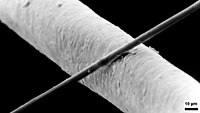
Photo from wikipedia
Abstract The torsional strength of reinforced concrete (RC) members is typically calculated through the thin-walled tube, space truss analogy. The governing equations are simple equilibrium conditions satisfied by closed stirrups,… Click to show full abstract
Abstract The torsional strength of reinforced concrete (RC) members is typically calculated through the thin-walled tube, space truss analogy. The governing equations are simple equilibrium conditions satisfied by closed stirrups, longitudinal reinforcement and spiral concrete diagonals at a variable angle. In building codes, like EC2 and ACI 318, the contribution of longitudinal reinforcement is averaged among the walls, considering the total amount of longitudinal re-bars of the overall cross section. However, longitudinal re-bars may be non-uniformly distributed along the walls. This is particular evident in beams with large aspect ratios and re-bars mainly located at the corners, or in beams with unsymmetrical bending-type longitudinal reinforcement arrangement. This paper presents a plasticity-based variable-angle space truss model accounting for non-uniform distribution of longitudinal reinforcement along the walls. The model, which is based on equilibrium conditions and the lower-bound theorem of plasticity, is first elaborated for a polygonal cross-section with an arbitrary number of walls incorporating arbitrary longitudinal reinforcement ratios and corresponding variable-angle concrete strut inclinations, and then particularized to the more common case of rectangular section with two representative longitudinal reinforcement ratios and two corresponding variable-angle strut inclinations. For practical design purposes, the results of this model are illustrated through normalized torsional strength curves in terms of non-dimensional reinforcement indexes. The model is validated by comparison with more than 200 experimental results of RC members under pure torsion collected from the literature, and very good agreement is found. The predictions of the model are also compared with those of some codes of practice and better results are obtained especially for beams with markedly non-uniform longitudinal reinforcement arrangement.
Journal Title: Engineering Structures
Year Published: 2020
Link to full text (if available)
Share on Social Media: Sign Up to like & get
recommendations!